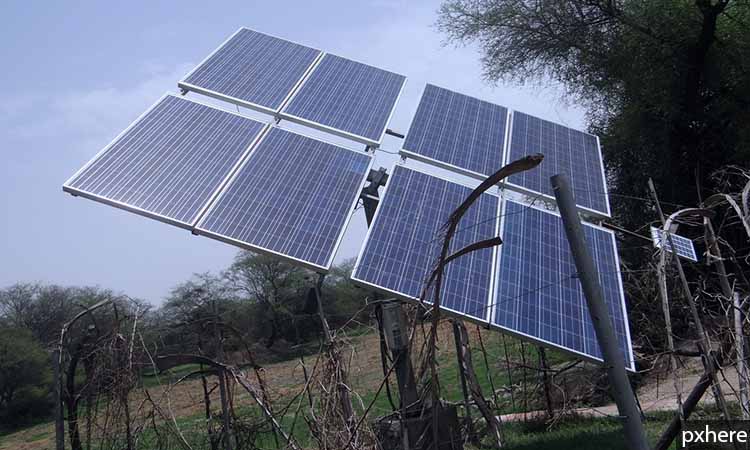Minister Claims 175 GW Green Energy By 2022; Study Says May Take 8 Years Longer

New Delhi: Minister for renewable energy R K Singh claimed that India now has 110 gigawatt (GW) of cumulative renewable energy capacity either installed or in the pipeline, and the country is headed to achieving the target of 175 GW of renewable capacity by 2022.
Delighted to announce that the cumulative Renewable Energy Capacity of 110,000 MW has been installed / is under implementation, out of which 70,000 MW has been installed, 15,000 MW is under construction & 25,000 MW has been tendered.
— R. K. Singh (@RajKSinghIndia) May 21, 2018
Ministry of New & Renewable Energy under the inspiring leadership of PM @NarendraModi, is steadfast in its mission of achieving 175 GW of renewable energy capacity across the nation by 2022.
— R. K. Singh (@RajKSinghIndia) May 21, 2018
Estimates from experts, however, reveal that at the current rates of progress, India is not likely to meet the target for the next decade.
A 175 GW renewable energy capacity is enough to replace 175 coal-fired power plants of 1,000 MW and reduce India’s dependence on fossil fuels. As much as 92% of India’s electricity comes from fossil fuels–that produce greenhouse gases and hasten global warming.
India will not be able to reach 175 GW installed capacity of green power before 2029-30 with the current policy and economic scenario, according to a May 2018 study by the Climate Policy Initiative (CPI), an advocacy.
By 2022, India would be reaching 83 GW of renewable capacity in a business-as-usual scenario, 86 GW in an optimistic scenario and 78 GW in a pessimistic scenario, according the CPI study prepared by researchers from Indian Institute of Technology, Delhi and Jawaharlal Nehru University .
Attempts to contact the power minister over telephone yielded no response. A detailed questionnaire has been sent to the minister. The article will be updated when he responds.
Researchers took into account different variables affecting the renewable energy sector and their future performance to project the scenarios. The variables include growth in gross domestic product, net energy imports along with demographic details such as population growth and number of households with access to electricity.
India would be reaching the green energy capacity target of 175 GW in 2027-28 under the optimistic scenario—where the health of the variables affecting the green energy growth is great--and a lot later, in 2032-33 in the pessimistic scenario, the study found.
India is currently the world's sixth largest renewable energy market with a well-diversified portfolio of regulatory policies as well as fiscal incentives, and public financing for renewable energy development and deployment, the report said.
Lack of transmission lines hindering growth
The main reason hindering India’s goal to reach 175 GW is the lack of transmission network to supply the renewable energy nationwide, according to the study.
The central government launched a programme to build an intra-state transmission system of 8,500 circuit-kilometer (ckt-km) by 2020, also called the green corridor, in 2015-16. The purpose of the transmission network is to evacuate and transmit nationwide the renewable energy produced in green energy rich states of Andhra Pradesh, Gujarat, Himachal Pradesh, Karnataka, Madhya Pradesh, Maharashtra, Rajasthan and Tamil Nadu.
A Parliament committee, in its report submitted to the Lok Sabha (lower house of Parliament) in March 2018, found that the speed of erecting the transmission lines is slow due to a mismatch of funding for the programme and the physical targets.
The target for 2018-19 is five times that of 2017-18 with a funding increase of only one-fifth between the two financial years, the report said, and urged the government to provide additional funds to build the transmission network within the deadline.
For 2017-18, Rs 5,000 crore ($770 million) was provided for installation of 350 ckt-km of transmission lines; for 2018-19, Rs 6,000 crore have been allocated for installation of 1,900 ckt-km, the report said .
India must install 5,500 ckt-km of transmission lines during 2019-20 to achieve the cumulative target of 8,500 ckt-km, the report added.
An estimated 7 GW of new renewable power projects are in the lurch because of the lack transmission lines, Mercom, a capital group, reported on May 21, 2018.
Other important reasons slowing the renewable capacity installation include the policy framework for renewable power makers moving from feed-in tariffs [tariff paid to renewable energy producers against the units of power fed-in to the grid] to auction-based purchases [where the capacity is allotted to be developed to the producer who bid the lowest]. Feed-in tariffs have traditionally gained the producers more than the prevailing electricity prices.
The concern among renewable energy advocates is that determining tariffs via competitive auction will drive renewable energy subsidies down or eliminate them entirely, according to this blog from The Energy Institute at Haas, a think-tank.
(Tripathi is a principal correspondent at IndiaSpend and FactChecker.)
We welcome feedback. Please write to respond@indiaspend.org. We reserve the right to edit responses for language and grammar.
__________________________________________________________________“Liked this story? Indiaspend.org is a non-profit, and we depend on readers like you to drive our public-interest journalism efforts. Donate Rs 500; Rs 1,000, Rs 2,000.”


